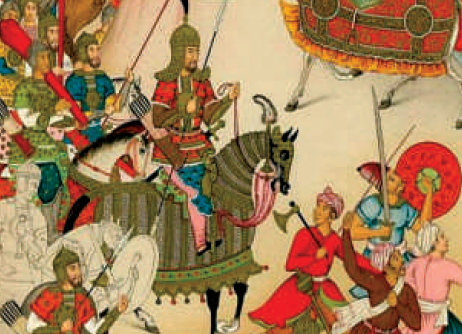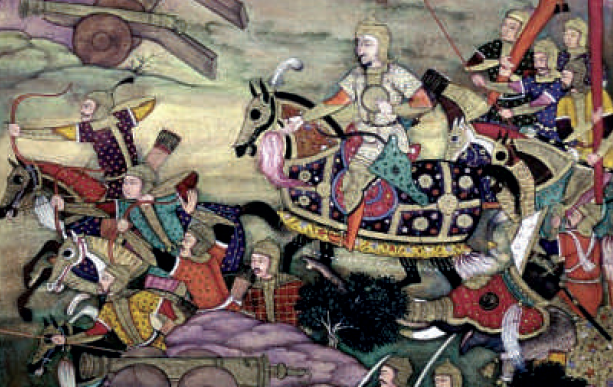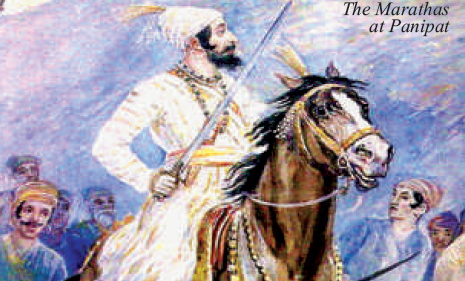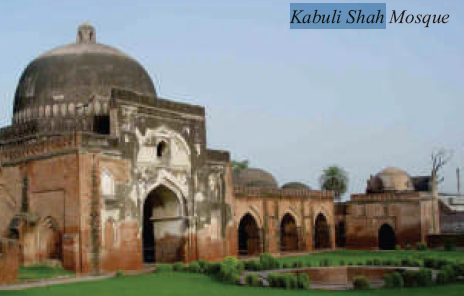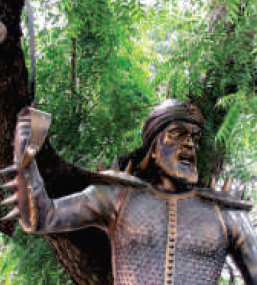Panipat: battles of
(Created page with "{| class="wikitable" |- |colspan="0"|<div style="font-size:100%"> This is a collection of articles archived for the excellence of their content.<br/>You can help by converting...") |
m (Pdewan moved page Panipat to Panipat: battles of without leaving a redirect) |
Revision as of 13:21, 16 February 2015
This is a collection of articles archived for the excellence of their content. Readers will be able to edit existing articles and post new articles directly |
Panipat
Panipat Wars and political upheaval
India Harmony Volume - 1 : Issue - 5 July-August, 2012
The legendary city of Panduprastha has in later times come to be known as Panipat. Legend has it that at the time of the battle of Mahabharata, five villages were demanded by the Pandavas from Duryodhana of which one was “Panipat”. This developed into one of the five cities-“prasthas”- founded by the Pandava brothers.
Panipat has been witness to many a major battles since the early 12th century. This little town has been the site for most of the battles for power in India. The name of this city occupies primacy in Indian history at a later period because three famous pivotal battles of Panipat were fought here over the two centuries between 1526 to 1756. But not many people know that it has been renowned for its intellectual and spiritual heritage, since the days of the early Muslim incursions into India in the twelfth century. The foreign armies brought with them spiritual seekers called Sufis. They settled here long before the Afghans and Sultans made this their home. Panipat was an ideal battleground for those who invaded India from the North and those who defended the country from the South. It lay on a piece of relatively high ground and between vast marshes on the West and the River Yamuna on the East. There was no good direct road to it; so it was not suitable for trade or commerce. Therefore, besides being a suitable battle ground, it was also a safe haven for Sufis.
In the 12th and 13th centuries the Afghans and Turkish armies established the Sultanate reign in Delhi. The Slave dynasty ruled over the entire northern and central India. This period ushered in an Indo-Islamic culture that left a rich legacy from fusion in art, architecture and literature. The Urdu language, which is a blend of the local Sanskrit/Prakrit spoken at that time and the Persian/Arabic languages of the immigrants, is also generally considered a heritage from the Sultanate period.
From the 13th through the early 16th centuries, the Delhi Sultanate was the dominant power in the Indian subcontinent. In addition to espousing a unique Indo-Islamic culture, the Delhi Sultanate maintained a certain degree of stability in the subcontinent, especially in North India. However, this period gave way to Mughal rule in 1526 when an ambitious conqueror by the name of Babur crushed the armies of the Lodhi Dynasty at the fields of Panipat, creating one of the largest power vacuums in Indian history. Here, India's history could have diverged spectacularly, as different factions competed for the spoils. Ultimately, it was Babur's grandson Akbar who would emerge triumphant and consolidate Mughal power.
Babur, a descendant of Timur and Genghis Khan came from the Fergana Valley (modern day Uzbekistan) across the Khyber Pass. India then had a large Delhi Sultanate ruled by Ibrahim Lodhi and Lahore (now in Pakistan) had a Lodhi Governor, Daulat Khan Lodhi. Babur won a succession of battles and made his intention clear of capturing Delhi. Babur had attempted to capture Delhi more than once but had lacked the resources to mount a sufficiently large expedition. However, the steady decline in popularity of Delhi's Sultan Ibrahim was a factor working strongly in Babur's favour. Babur seized the opportunity by uniting his followers in an adventure which, if successful, would offer them boundless wealth.
The ruler of Delhi Ibrahim Lodhi decided to oppose Babur at Panipat. He had great confidence in his elephant corps. He thus marched from Delhi to accost Babur. The battle at Panipat has gone down in history as a watershed as Babur faced a much larger force of 100,000 along with a vast elephant corps.
Babur had a force only 24,000 but he had lined up cannons which at that time were an unknown commodity in India. In addition like a shrewd general he chained all the guns together so that Lodhi's elephant corps could not break through. The battle was swift and Babur opened up with his guns. The ensuing smoke and sound of gun fire had a deleterious effect on the elephant corps and the much needed elephant charge never took place. Ibrahim Lodhi was killed in battle and his army defeated in half a day. Babur entered Delhi triumphantly. Babur's guns and fine skills as a commander brought him a well deserved victory which changed the course of Indian history. Humayun, the eldest son of Babur, was dispatched to seize Sultan Ibrahim's household and treasure at Agra while Babur, himself, advanced on Delhi.
Babur's Mughal Empire, would one day cover modern day Afghanistan, Pakistan, India and Bangladesh. His decisive victory in the First Battle of Panipat resulted in enormous political upheaval in North India, with various factions vying to fill the power vacuum created by the collapse of the Delhi Sultanate. Having died just five years after this great victory, Babur was unable to consolidate his conquests. His successor Humayun also failed, facing enormous competition from the Suri dynasty. Humayun was defeated by the Afghan warrior Sher Shah Suri in the year 1540, and was forced to retreat to Kabul.
The second battle of Panipat
In this chaotic environment for a brief period, Emperor Hemu Vikramaditya, came to power who attempted to recreate a new empire in North India. After Sher Shah's death, his son Islam Shah Suri together with Samrat Hem Chandra Vikramaditya, won 22 battles against Afghan rebels and forces of Akbar. Hemu after a succession of victories against the Sultans had entered Delhi and was crowned as King in the Purana Quila –the fort built by Sher Shah Suri. They ruled from Punjab to Bengal, had succeeded establishing a secular rule in North India from Delhi. However, in 1556, Babur's grandson Akbar rose to the challenge and decisively defeated Hemu, thus consolidating the Mughal Empire. Akbar who was just 13 years old faced Hemu along with his regent and general - Bairam Khan. The setting for the second great battle was again at Panipat. The battle is of great historical importance as Hemu straight away went on the offensive. Repeated charges by the elephant corps of Hemu soon had the Mughal army in disarray. Despondency set in and the Mughals were thinking of breaking battle and retreating. Hemu proved himself an able commander as he directed the battle from the vantage point of his elephant skillfully. But then providence took a hand and a stray arrow hit Hemu's eye and he was rendered unconscious. This had a deleterious effect on his army and the Mughals converted a lost battle into victory. Akbar's forces defeated and killed Hemu in the Second Battle of Panipat on 6 November 1556 and re-established Moghul rule.
Thereafter, The Mughal Empire became the dominant power in the Indian subcontinent between the mid-16th century and the early 18th century.
The third battle of Panipat
Mughal rule entered its twilight after the demise of Aurengzeb and his successors had to face concerted attacks from the Marathas. The Maratha confederacy existed from 1674 to 1818. The third and the final battle of Panipat was fought on January 14th, 1761 was between the forces of the Maratha Confederacy and the coalition of the kings of Afghanistan, Ahmad Shah Durrani (also known as Ahmed Shah Abdali) and his two Indian allies; The Rohilla Afghans of Doab and the Nawab of Oudh, Shuja-ud-Saula. The battle was fought at Panipat.
The third battle of Panipat is known to be one of the largest battles fought in the 18th century and perhaps has the largest casualties in a single day reported in a classic formation between two armies. What followed were a string of clashes by the banks of the Yamuna River, including the Battle of Kunjipur, which the Marathas won, against an Afghan army of about 15000 men. Abdali and other Afghan forces were on the eastern side of the Yamuna, however Abdali daringly crossed over the river on October 25th at Baghpath, cutting off the Maratha camp from their base in Delhi. This led to a two month long siege led by Abdali against the Marathas in the town of Panipat. Finally, faced with starvation, the Marathas marched towards the Afghan camp. The two armies came face to face at 8 am and the war waged on till the evening resulting in victory for Ahmad Shah Abdali and his army.
The result of the war was that the Maratha advances over North India were halted and their territories were destabilized. Sadashiv Rao Bhau was killed in the war. His body was recovered by the Afghans and under the personal direction of Ahmad Shah was cremated according to Hindu customs. The third battle of Panipat saw an enormous number of casualties and deaths in a single day of battle. This was the last major battle between indigenous South Asian military powers until the creation of Pakistan in 1947.
The Third Battle of Panipat in 1761, like the First, created a huge power vacuum in India. The battle marked the beginning of the decline of the Marathas, who would be progressively weakened in three devastating wars against the British. However, the battle proved costly for both sides, and weakened the Durranis as well as the Marathas. The weakening of India's largest powers in this battle was more crucial to the overall British success in India than the Battle of Plassey itself. After 1761, conflicts in India would almost exclusively involve the British.
The Third Battle of Panipat set in stone a distinct cultural gap in the subcontinent. For most of history, the area corresponding to modern-day Afghanistan and Pakistan's tribal areas were considered the "natural frontiers" of India. Unsurprisingly, Indian empires with their base of power in the Indo-Gangetic Plain had their political frontiers in those regions, and the people of the frontiers were considered to be highly Indianized. This changed in the 18th century, when the collapse of the Mughal Empire, coupled with the rise of tribal Afghan dynasties like the Durranis, permanently pulled the frontier regions out of the cultural orbit of the Gangetic states. The repercussions of this highly significant development can still be felt today. The three crucial battles in Panipat practically changed the history of the subcontinent – the first two consolidating Mughal power and the last one ushering in British reign.
Present day Panipat has a war museum and memorial, the Kabuli mosque, the tomb of Ibrahim Lodhi among other historical sites. Ibrahim Lodi is buried here after he was defeated by Babur in 1526. His grave is a simple tomb; just a rectangular block on a high platform approached by a flight of steps made of lakhori bricks. The tomb was renovated by the British in 1866.
The Kabuli Shah mosque was built by Babur after his victory over Ibrahim Lodhi. He named the mosque after his wife Kabuli Begum. Six years later when Humayun defeated Salim Shah, he got a platform called Chabutara Fateh Mubarak made around the mosque. The mosque has chambers on two sides and an inscription in Persian runs along the parapet.
